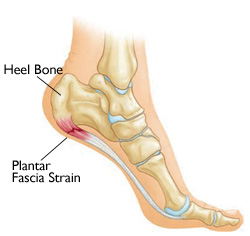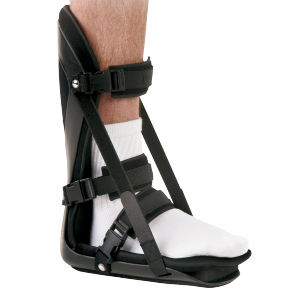Does your foot or heel hurt with the first couple steps in the morning? What about after standing or walking for a long time? Chances are you have plantar fasciitis and physical therapy can help! Plantar Fasciitis is the most common foot condition treated by healthcare providers, and an estimated 2 million Americans will suffer each year.
 The plantar fascia a thick band of connective tissue (fascia) that runs from the calcaneal tubercle (heel) to the bottom of the toes. It supports the arch of the foot, and during walking it functions during heel rise to allow for plantar flexion (pushing your toes down) and to prevent the calcaneus (heel) from everting (turning out), which is known as the “windlass mechanism.”
The plantar fascia a thick band of connective tissue (fascia) that runs from the calcaneal tubercle (heel) to the bottom of the toes. It supports the arch of the foot, and during walking it functions during heel rise to allow for plantar flexion (pushing your toes down) and to prevent the calcaneus (heel) from everting (turning out), which is known as the “windlass mechanism.”
Is it plantar fasciitis or plantar fasciosis? Although initially believed to be an inflammatory condition, it is now better understood as degenerative changes to the fascia, stiffening and thickening that can result from micro-tears in the plantar fascia. If there is a stiffening or thickening, then your recovery time may be longer than expected.
 Symptoms can range from: pain most noticeable with initial steps after a period of inactivity (first thing in the morning or after prolonged sitting); often worse with prolonged weight bearing (standing), and/or often precipitated by increase in weight bearing activity. Some common causes and risk factors can include: age 40-60 (most common), obesity, occupations that keep you on your feet, activities that place a lot of stress on the heel (long-distance running, ballet, dancing), limited ankle dorsiflexion (poor calf flexibility), faulty foot mechanics (over-pronation, high arch, altered distribution of weight), improper shoes (too loose, too thin, no arch support, high heels, untrained barefoot running), faulty running mechanics, and training errors (increasing mileage too quickly). A diagnosis may be needed from a physician, with a possible x-ray to rule out heel spurs or a stress fracture.
Symptoms can range from: pain most noticeable with initial steps after a period of inactivity (first thing in the morning or after prolonged sitting); often worse with prolonged weight bearing (standing), and/or often precipitated by increase in weight bearing activity. Some common causes and risk factors can include: age 40-60 (most common), obesity, occupations that keep you on your feet, activities that place a lot of stress on the heel (long-distance running, ballet, dancing), limited ankle dorsiflexion (poor calf flexibility), faulty foot mechanics (over-pronation, high arch, altered distribution of weight), improper shoes (too loose, too thin, no arch support, high heels, untrained barefoot running), faulty running mechanics, and training errors (increasing mileage too quickly). A diagnosis may be needed from a physician, with a possible x-ray to rule out heel spurs or a stress fracture.
Physical Therapy will most likely focus on:
- stretching of plantar fascia, gastrocnemius, and soleus (calf),
- strengthening of the intrinsic muscles of the feet can assist to decrease the stress placed on the fascia – using toe or towel scrunches; calf raises; theraband for dorsiflexion, plantar flexion, inversion and eversion
- manual therapy – massage, mobilizations of the joints in your ankle and foot that may be less mobile, creating more stress on the plantar fascia
- taping to decrease stress on the plantar fascia
- night splints/boots/socks have been most effective in chronic patients with pain lasting more than 6 months
- Modalities – ultrasound (therapeutic deep heat), iontophoresis (non-invasive way to deliver anti-inflammatory medication locally to site), ice/heat
- Orthotics – good short- and long-term results with prefabricated and custom orthotics
- Injections – improvement is often temporary, pain relieved but often replaced with arch strain, plantar nerve pain, stress fracture and/or hammertoe deformity, rare cases of plantar fascia rupture with repeated injections
- Surgery – necessary in less than 5% of patients

The best treatment is prevention, first through good shoe wear with stretching and strengthening. Recent research suggests: prefabricated shoe insert PLUS stretching. The prognosis is good in that approximately 90% of patients have resolution of symptoms in 10 months or less! If you have tried self-treating with little-to-no results, then the next step recommended would be to consult your MD or PT.



I had been suffering from plantar fasciitis for years, to the point where my hip and bасk have problems due to changing the way I walk to minimize pain caused from plantar fasciitis. I had tried many treatments from physiotherapy, acupuncture, orthotics and medication, they helped me a bit but the result was temporary.. Last year I found this guide while doing research about this annoying problem here http://www.calminghealth.com/march-3/cure-plantar-fasciitis-naturally?12 and decided to take another shot, without hoping much. Within a week my symptoms such as stabbing pain in my heel gradually gone, but I thought it was just temporally. And surprisingly, I don’t have these symptoms until today! I was nearly opt for surgery as my GP suggested but now I don’t need it anymore. I hope more people not losing hope – there are natural methods to deal with this disease effectively and naturally.
a very informative article. I have been having this pain for about six months